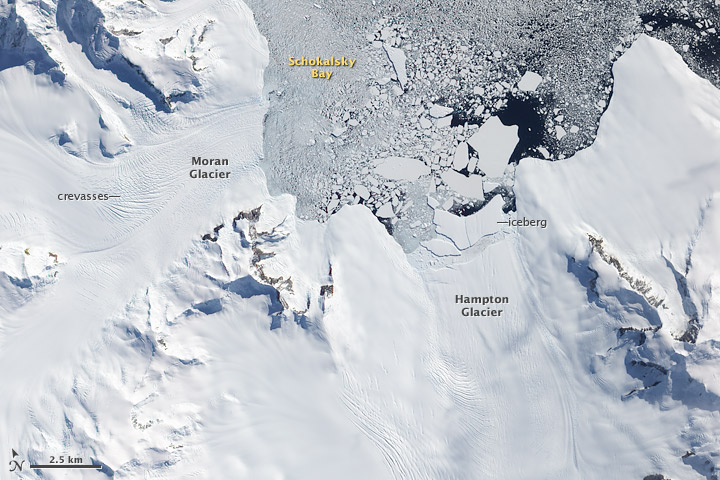English: Few places on Earth have warmed more rapidly in recent decades than the Antarctic Peninsula, a narrow, mountainous spine of land that juts out from the continent into the Southern Ocean. More than 400 glaciers—often steep and heavily traced with crevasses—flow out of nearly every nook and cranny of the rugged peninsula, and the regional warming has caused the edges of many of these glaciers to retreat and their flow toward the ocean to accelerate. Faster flow of tidewater glaciers on the Antarctic Peninsula is adding directly to sea level rise.
This image of the northern tip of Alexander Island, near the western base of the Antarctic Peninsula, illustrates one of the processes through which glaciers can contribute to sea level rise: iceberg production. In this image, several large icebergs have calved from Hampton Glacier. Near the glacier, the bergs appear to be partially held in place by a mélange of ice that may include tiny iceberg fragments and frozen sea water. Farther out in Shokalsky Bay, the icebergs are floating more freely. Eventually, the bergs will drift northward to warmer waters, where they will melt.
All glaciers that end in the ocean (called tidewater glaciers) periodically calve icebergs. When iceberg production is matched by snowfall accumulation on the glacier, the glacier is not contributing to sea level rise: all the water it adds to the ocean eventually returns to the glacier as snow. But if iceberg production (or a combination of iceberg production and melting) outpaces snowfall accumulation, then the glacier is contributing to sea level rise.
Measuring the thickness and flow rates of glaciers on the Antarctic Peninsula is one of the objectives of an upcoming NASA aircraft campaign called Operation Ice Bridge. Beginning on October 12, 2009, and continuing for 6 weeks, NASA’s DC-8 research airplane and the Ice Bridge team scientists will make a series of flights from a base in southern Chile to collect observations over West Antarctica, the Antarctic Peninsula, and coastal areas where sea ice is prevalent. Each round-trip flight lasts about eleven hours, two-thirds of that time devoted to getting to and from Antarctica.
References
Pritchard, H.D., and Vaughan, D.G. (2007). Widespread acceleration of tidewater glaciers on the Antarctic Peninsula. Journal of Geophysical Research, 112, F03S29.





